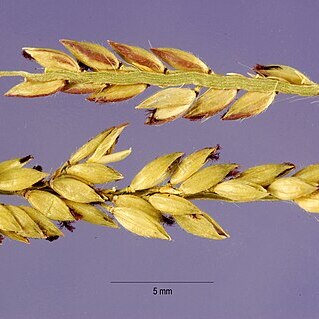Spikelets 1-fld, racemose, very shortly pediceled in 2 rows along one side of a rachis, lance-ovoid or ellipsoid; rachilla-joint thickened, forming a ring-like callus below the second glume, the virtually obsolete first glume adnate to it, the spikelet appearing to be set in a thickened, shallow cup atop the pedicel; second glume and sterile lemma chartaceous, 5–7-veined, usually pilose, similar and subequal or the glume a little the longer; fertile lemma surpassed by the second glume, cartilaginous, finely rugulose or papillate-roughened, usually mucronate or awned, the inrolled margins clasping a palea of similar texture and about equal length; tufted grasses with terminal panicles of several, usually appressed racemes. 25, warm reg.
Annuals or perennials. Leaf blades linear, flat; ligule ciliate. Inflorescence of racemes along a central axis, spikelets pedicellate, single, paired or clustered on a narrow rachis, adaxial. Spikelets lanceolate to elliptic, thinly biconvex, subcartilaginous, acute to aristate, a little globose swelling at spikelet base, florets 2; lower glume vestigial; upper glume equaling spikelet, facing outward, often awn-pointed; lower lemma similar but usually slightly shorter, neuter or staminate, with or without palea; upper lemma crustaceous, papillose, margins inrolled, apex obtuse and often mucronate. x = 9.
Spikelets usually in pairs, arranged in two rows on one side of a slender rachis, the back of the fruit turned away from the rachis; first glume united with the thickened first segment of the rachilla, forming a ring-like callus below the second glume; second glume and sterile lemma equal or nearly so, acute or acuminate, 3-nerved; fruit much shorter than the second glume and sterile lemma (in our species), elliptic, awnless or short-awned, minutely striate and cross-wrinkled or papillose-roughened, the margins of the lemma firm, inrolled, rather tightly en-closing the palea.
Inflorescence a panicle condensed about the primary branches or of racemes along a central axis, the spikelets single and abaxial, paired or on short side branchlets.
Spikelets lanceolate to narrowly ovate, thinly biconvex, acute to aristate, with a little globose bead at the base.
Inferior glume vestigial (except E. meyeriana, E. rovumensis),adnate to swollen basal internode of rhachilla.
Superior glume as long as spikelet, often with an awn-point.
Superior lemma coriaceous, granulose, usually mucronate.


